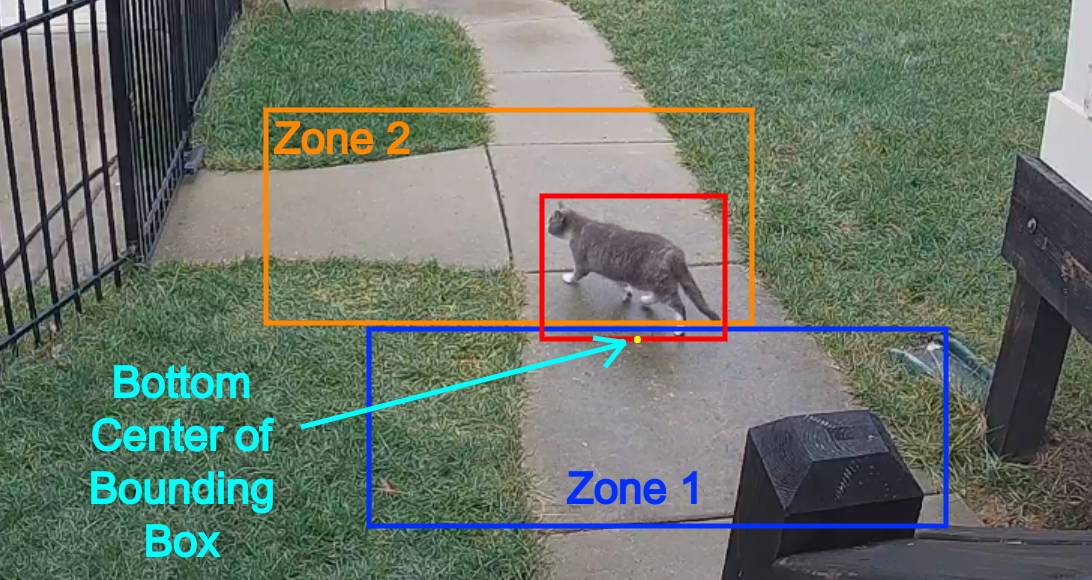Zones
Zones allow you to define a specific area of the frame and apply additional filters for object types so you can determine whether or not an object is within a particular area. Presence in a zone is evaluated based on the bottom center of the bounding box for the object. It does not matter how much of the bounding box overlaps with the zone.
For example, the cat in this image is currently in Zone 1, but not Zone 2.

Zones cannot have the same name as a camera. If desired, a single zone can include multiple cameras if you have multiple cameras covering the same area by configuring zones with the same name for each camera.
During testing, enable the Zones option for the Debug view of your camera (Settings --> Debug) so you can adjust as needed. The zone line will increase in thickness when any object enters the zone.
To create a zone, follow the steps for a "Motion mask", but use the section of the web UI for creating a zone instead.
Restricting alerts and detections to specific zones
Often you will only want alerts to be created when an object enters areas of interest. This is done using zones along with setting required_zones. Let's say you only want to have an alert created when an object enters your entire_yard zone, the config would be:
cameras:
name_of_your_camera:
review:
alerts:
required_zones:
- entire_yard
zones:
entire_yard:
coordinates: ...
You may also want to filter detections to only be created when an object enters a secondary area of interest. This is done using zones along with setting required_zones. Let's say you want alerts when an object enters the inner area of the yard but detections when an object enters the edge of the yard, the config would be
cameras:
name_of_your_camera:
review:
alerts:
required_zones:
- inner_yard
detections:
required_zones:
- edge_yard
zones:
edge_yard:
coordinates: ...
inner_yard:
coordinates: ...
Restricting snapshots to specific zones
cameras:
name_of_your_camera:
snapshots:
required_zones:
- entire_yard
zones:
entire_yard:
coordinates: ...
Restricting zones to specific objects
Sometimes you want to limit a zone to specific object types to have more granular control of when alerts, detections, and snapshots are saved. The following example will limit one zone to person objects and the other to cars.
cameras:
name_of_your_camera:
zones:
entire_yard:
coordinates: ... (everywhere you want a person)
objects:
- person
front_yard_street:
coordinates: ... (just the street)
objects:
- car
Only car objects can trigger the front_yard_street zone and only person can trigger the entire_yard. Objects will be tracked for any person that enter anywhere in the yard, and for cars only if they enter the street.
Zone Loitering
Sometimes objects are expected to be passing through a zone, but an object loitering in an area is unexpected. Zones can be configured to have a minimum loitering time before the object will be considered in the zone.
cameras:
name_of_your_camera:
zones:
sidewalk:
loitering_time: 4 # unit is in seconds
objects:
- person
Zone Inertia
Sometimes an objects bounding box may be slightly incorrect and the bottom center of the bounding box is inside the zone while the object is not actually in the zone. Zone inertia helps guard against this by requiring an object's bounding box to be within the zone for multiple consecutive frames. This value can be configured:
cameras:
name_of_your_camera:
zones:
front_yard:
inertia: 3
objects:
- person
There may also be cases where you expect an object to quickly enter and exit a zone, like when a car is pulling into the driveway, and you may want to have the object be considered present in the zone immediately:
cameras:
name_of_your_camera:
zones:
driveway_entrance:
inertia: 1
objects:
- car
Loitering Time
Zones support a loitering_time configuration which can be used to only consider an object as part of a zone if they loiter in the zone for the specified number of seconds. This can be used, for example, to create alerts for cars that stop on the street but not cars that just drive past your camera.
cameras:
name_of_your_camera:
zones:
front_yard:
loitering_time: 5 # unit is in seconds
objects:
- person